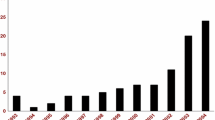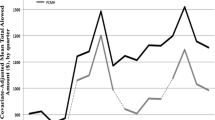Abstract
This research compares the behavior of non-profit organizations and private for-profit firms in the hospice industry, where there are financial incentives created by the Medicare benefit. Medicare reimburses hospices on a fixed per diem basis, regardless of patient diagnosis. Because under this system patients with lower expected costs are more profitable, hospices can selectively enroll patients with longer lengths of stay. While it is illegal for hospices to reject potential patients explicitly, they can influence their patient mix through referral networks. A fixed per diem rate also creates an incentive shirk on quality and to substitute lower skilled for higher skilled labor, which has implications for quality of care. By using within-market variation in hospice characteristics, the empirical evidence suggests that for-profit hospices differentially take advantage of these incentives. The results show that for-profit hospices engage in patient selection through significantly different referral networks than non-profits. They receive more patients from long-term care facilities and fewer patients through more traditional paths, such as physician referrals. This mechanism of patient selection is supported by the result that for-profits have fewer cancer patients and more patients with longer lengths of stay. While non-profit and for-profit hospices report similar numbers of staff visits per patient, for-profit firms make significantly less use of skilled nursing providers. We also find some weak evidence of lower levels of quality in for-profit hospices.
Similar content being viewed by others
References
Cameron A. C., Trivedi P. K. (1998) Regression analysis of count data. Cambridge University Press, Cambridge
Carlson M., Gallo W., Bradley E. (2004) Ownership status and patterns of care in hospice: Results from the national home and hospice care survey. Medical Care 42(5): 432–438
Carney K., Burns N., Brobst B. (1989) Hospice costs and medicare reimbursement: An application of breakeven analysis. Nursing Economics 7(1): 41–48
Chou S.-Y. (2002) Asymmetric information, ownership and quality of care: An empirical analysis of nursing homes. Journal of Health Economics 21(2): 293–311
Christakis N. A., Escarce J. J. (1996) Survival of Medicare patients after enrollment in hospice programs. New England Journal of Medicine 335(3): 172–178
Cohen J. W., Dubay L. C. (1990) The effects of Medicaid reimbursement method and ownership on nursing home costs, case mix and staffing. Inquiry 27(2): 183–200
Cohen J. W., Spector W. D. (1996) The effect of Medicaid reimbursement on quality of care in nursing homes. Journal of Health Economics 15(1): 23–48
Cutler, D. M., & Horwitz, J. R. (2000). Converting hospitals from not-for-profit to for-profit status: Why and what effects? In The changing hospital industry: Comparing not-for-profit and for-profit institutions (pp. 45–79). Chicago: University of Chicago Press.
Duggan M. (2000) Hospital ownership and public medical spending. Quarterly Journal of Economics 115(4): 1343–1374
Feldstein M. (1971) Hospital cost inflation: A study of nonprofit price dynamics. The American Economic Review 61(5): 853–872
Frank R., Salkever D. S. (1991) The supply of charity services by nonprofit hospitals: Motives and market structure. Rand Journal of Economics 22(3): 430–445
Gertler P. J. (1989) Subsidies, quality, and the regulation of nursing homes. Journal of Public Economics 38: 33–52
Glaeser E. L., Shleifer A. (2001) Not-for-profit entrepreneurs. Journal of Public Economics 81(1): 99–115
Grabowski D. C., Hirth R. A. (2003) Competitive spillovers across nonprofit and for-profit nursing homes. Journal of Health Economics 22(1): 1–22
Hamilton V. (1994) The impact of ownership form and regulatory measures on firm behavior: A study of hospices. Nonprofit Management and Leadership 4(4): 415–430
Hansmann H. (1980) The role of nonprofit enterprise. Yale Law Journal 89(3): 835–901
Hirth R. (1999) Consumer information and competition between non-profit and for-profit nursing homes. Journal of Health Economics 18: 219–240
Horwitz, J. (2005). Does corporate ownership matter? Service provision in the hospital industry. NBER Working Paper No. 11376.
Huskamp H. A., Buntin M. B., Wang V., Newhouse J. P. (2001) Providing care at the end of life: Do medicare rules impede good care?. Health Affairs 20(3): 204–211
Krauss, N. A., & Altman, B. M. (1999). Characteristics of nursing home residents—1996. Agency for Health Care Policy and Research Pub. No. 99-0006.
Lindrooth R., Weisbrod B. (2007) Do religious nonprofit and for-profit organizations respond differently to financial incentives? The hospice industry. Journal of Health Economics 26(2): 342–357
Magaziner J., German P., Zimmerman S. W. et al (2000) The prevalence of dementia in a statewide sample of new nursing home admissions aged 65 and older: Diagnosis by expert panel. The Gerontologist 40(6): 663–672
McClellan, M., & Staiger, D. (2000). Comparing hospital quality at for-profit and not-for-profit hospitals. In The changing hospital industry: Comparing not-for-profit and for-profit institutions (pp. 93–112). Chicago: University of Chicago Press.
Medicare Payment Advisory Commission. (2004). Report to the congress: New approaches in Medicare. Washington: MedPAC.
National Hospice and Palliative Care Organization. (2004). NHPCO’s 2004 facts and figures. http://www.nhpco.org/templates/1/homepage.cfm.
Newhouse J. P. (1970) Toward a theory of nonprofit institutions: An economic model of a hospital. The American Economic Review 60(1): 64–74
Nicosia, N., Reardon, E., Lorenz, K., Lynn, J., & Buntin, M. B. (2006). The Medicare hospice payment system: A preliminary consideration of potential refinements. RAND Health Working Paper, WR-401-MedPAC.
Norton E. C., Staiger D. O. (1994) How hospital ownership affects access to care for the uninsured. RAND Journal of Economics 25: 85–171
Nyman J. A. (1988) Improving the quality of nursing home outcomes—Are adequacy or incentive oriented policies more effective?. Medical Care 26(12): 1158–1171
O’Meara, J., Graham, C., Laborde, N., Collier, E., & Harrington, C. (2005). Guide to understanding hospice data on CALNHS.org. San Francisco: Department of Social and Behavioral Sciences, University of California.
Shen Y.-C. (2002) The effect of hospital ownership choice on patient outcomes after treatment for acute myocardial infarction. Journal of Health Economics 21(5): 901–922
Silverman, E., & Skinner, J. (2001). Are for-profit hospitals really different? Medicare upcoding and market structure. NBER Working Paper No. 8133.
Sloan F. A., Picone G. A., Taylor D. H., Chou S.-Y. (2001) Hospital ownership and cost and quality of care: Is there a dime’s worth of difference?. Journal of Health Economics 20(1): 1–21
Teno J. M., Weitzen S., Fennell M., Mor V. (2001) Dying trajectory in the last year of life: Does cancer trajectory fit other diseases?. Journal of Palliative Medicine 4(4): 457–464
US Department of Labor, Bureau of Labor Statistics. (2005). May 2005 National industry-specific occupational employment and wage estimates. NAICS 621600, Home Health Care Services. http://www.bls.gov/oes/2005/may/oes_nat.htm. Accessed April 5, 2012.
U.S. General Accounting Office. (2000). Medicare: More beneficiaries use hospice but for fewer days of care. Washington, DC: GAO-T-HEHS-00-201, September.
U.S. Government Accountability Office. (2004). Medicare hospice care: Modifications to payment methodology may be warranted. Washington, DC: GAO-05-42, October.
Weisbrod B. A. (1988) The nonprofit economy. Harvard University Press, Cambridge
Weisbrod, B., & Schlesinger, M. (1986). Public, private, nonprofit ownership, and the response to asymmetric information: The case of nursing homes. In The economics of nonprofit institutions. New York: Oxford University Press.
Author information
Authors and Affiliations
Corresponding author
Rights and permissions
About this article
Cite this article
Gandhi, S.O. Differences between non-profit and for-profit hospices: patient selection and quality. Int J Health Care Finance Econ 12, 107–127 (2012). https://doi.org/10.1007/s10754-012-9109-y
Received:
Accepted:
Published:
Issue Date:
DOI: https://doi.org/10.1007/s10754-012-9109-y




